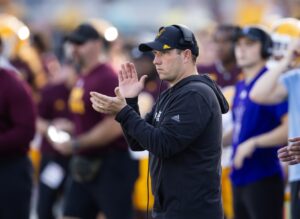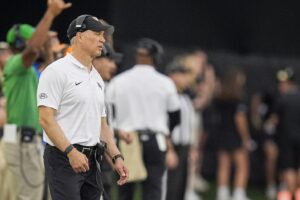Before the 2021 season began, several comparisons were drawn between this year’s Hawkeye football team and the 2009 team that won the Orange Bowl. Both teams operated under a second-year starting quarterback had a stand-out defense, and solid special teams. Both the 2009 and 2021 teams finished the regular season 10-2. This year, Iowa advanced to the Big Ten Championship game where Michigan handed the Hawkeyes their third loss. In 2009, there was no conference championship game. However, Ohio State won the Big Ten that year at 10-2 with a head-to-head overtime victory against Iowa. Now that the regular season is over, the end-of-season comparison with the 2009 Hawkeyes reveals incredible similarities.
Offense
Passing Game
The Hawkeye offense was under some pressure this season for its lack of explosive plays, play calling, and overall underwhelming performance. While there is merit to those arguments, Spencer Petras and Alex Padilla led this year’s Hawkeyes to 10 regular-season wins; something that Kirk Ferentz had only done three times prior in his 23 seasons at Iowa. On offense, Iowa averaged 23.9 points per game this season. In its 13 games, the offense scored a total of 311 points. In 2009, Ricky Stanzi and his offense scored 23.2 points per game. They tallied 301 total points in 13 games.
Stanzi played in 10 regular-season games in 2009. James Vandenburg replaced him when he was injured for the final two and a half games. The two threw for 2,887 yards on the season with 19 touchdowns on 392 attempts. The 2021 team had a similar personnel situation in that Petras played in just 10 regular-season games this year. Padilla replaced Petras when he was injured, and started the final three games of the regular season. Petras and Padilla threw the ball for 2,310 yards with 11 touchdowns on 374 attempts. The 2009 passing game was more efficient than the 2021 team, but Stanzi threw 15 interceptions. Petras has thrown just 11 in his entire career. This year’s team also ran 851 plays, just five more than the 2009 team.
Backfield
Iowa’s 2009 team dealt with some running back issues and primarily worked with true freshmen in the backfield in Adam Robinson and Brandon Wegher. The two gathered 1,475 yards on the year with 13 touchdowns. On the ground that season, the Iowa offense averaged just over three yards per attempt. The 2021 backfield was dominated by Tyler Goodson. The junior running back surpassed 1,000 yards on the season and had six touchdowns. He was accompanied by Gavin Williams and Ivory Kelly-Martin, and the group as a whole averaged exactly 3.27 yards per attempt on the year with 1,548 total yards. On the offensive line, both teams had a first-team All-American selection. This year, it was center Tyler Linderbaum, and in 2009, Bryan Bulaga received first-team honors at tackle.
Defense
Iowa’s defense this season was one of the best in the nation. The unit gave up just 19.2 points per game and led the country with 24 interceptions on the year. The defense also had an All-American selection in Riley Moss. At cornerback, Moss had four interceptions, two defensive touchdowns, and a fumble recovery. He did not allow a single touchdown in coverage all season. The 2009 defense stacked up very similarly. Norm Parker’s unit gave up 15.4 points per game and grabbed 21 interceptions. That interception total was tied for third in the country in 2009. Pat Angerer was named an All-American that year at linebacker. He finished with 145 tackles that year and hauled in an interception for good measure. Angerer was a first-team selection.
On third downs, the 2009 and 2021 teams had nearly identical defensive stop rates. This season, Phil Parker’s defense forced 200 third downs and gave up 73 conversions. That’s a 36.5% success rate given up, and the fifth most third downs forced in the nation. In 2009, the Hawkeye defense forced 199 third downs and gave up 71 conversions for a 35.7% success rate. These numbers are almost identical, and the team defensive stats are very similar. Both Phil and Norm run a bend, don’t break style, and rarely allow big plays or a lot of points.
Special Teams
This year’s team had the advantage in placekicker with Caleb Shudak. The Lou Groza Award semifinalist finished the year 23 of 27 for field goals, with four makes coming from 50 yards or more. Shudak was also 100% on extra points this season. In 2009, Daniel Murray was 19 of 26 from the field and missed just one extra point on the season.
In the kick return game, Charlie Jones returned 23 kickoffs for an average of 26.3 yards per return. He also took one 100 yards for a touchdown against Illinois this season. That kick return touchdown was the longest in program history since CJ Jones’ 100-yard opening kickoff return in the 2003 Orange Bowl. Jones also returned punts this year, averaging nearly eight yards per return. He was awarded First-Team All-Big Ten return specialist at the end of the season. In 2009, Darrell Johnson-Koulianos returned 12 kickoffs for an average of 31.5 yards per attempt. Like Jones, Johnson-Koulianos returned one for a touchdown. It came against Ohio State for 99 yards, the second-longest in program history.
Both the 2009 and 2021 teams blocked a punt for a touchdown as well. In 2009, Adrian Clayborn blocked a Penn State punt in Happy Valley and took it 53 yards for a touchdown. The score came early in the fourth quarter and turned the momentum of the game. Iowa went on to beat the fifth-ranked Nittany Lions. This year in Lincoln, Henry Marchese got a hand up and deflected a Nebraska punt early in the fourth quarter. Kyler Fisher caught the ball and took it 27 yards into the end zone. The special teams’ touchdown gave a huge burst of momentum to the Hawkeyes, who went on to beat Nebraska 28-21.
End of Season Comparison with the 2009 Hawkeyes
Expectations were scattered for this Hawkeye football team back in August. The over/under win total was set at a reasonable eight-and-a-half wins. However, there was a huge amount of potential in this team. Both the 2009 team and the 2021 team finished their previous seasons on a hot streak and kept it going into the next year. Both teams finished the regular season with 10 wins and the second-best record in the Big Ten. Winning ten regular-season games at the Big Ten level is something that Ferentz’s team has only done four times. The 2009 Iowa football season will always be remembered as one of Ferentz’s best teams. The 2021 team is right there with them.
In 2009, Iowa reached as high as the fourth-ranked team in the nation in the BCS rankings, the highest of any Big Ten team that year. This season, Iowa got all the way up to number two and even received one first-place vote. That’s something no other Big Ten team can claim this year. In the end-of-season comparison with the 2009 Hawkeyes, this year’s football team proved they were one of the best in program history.






